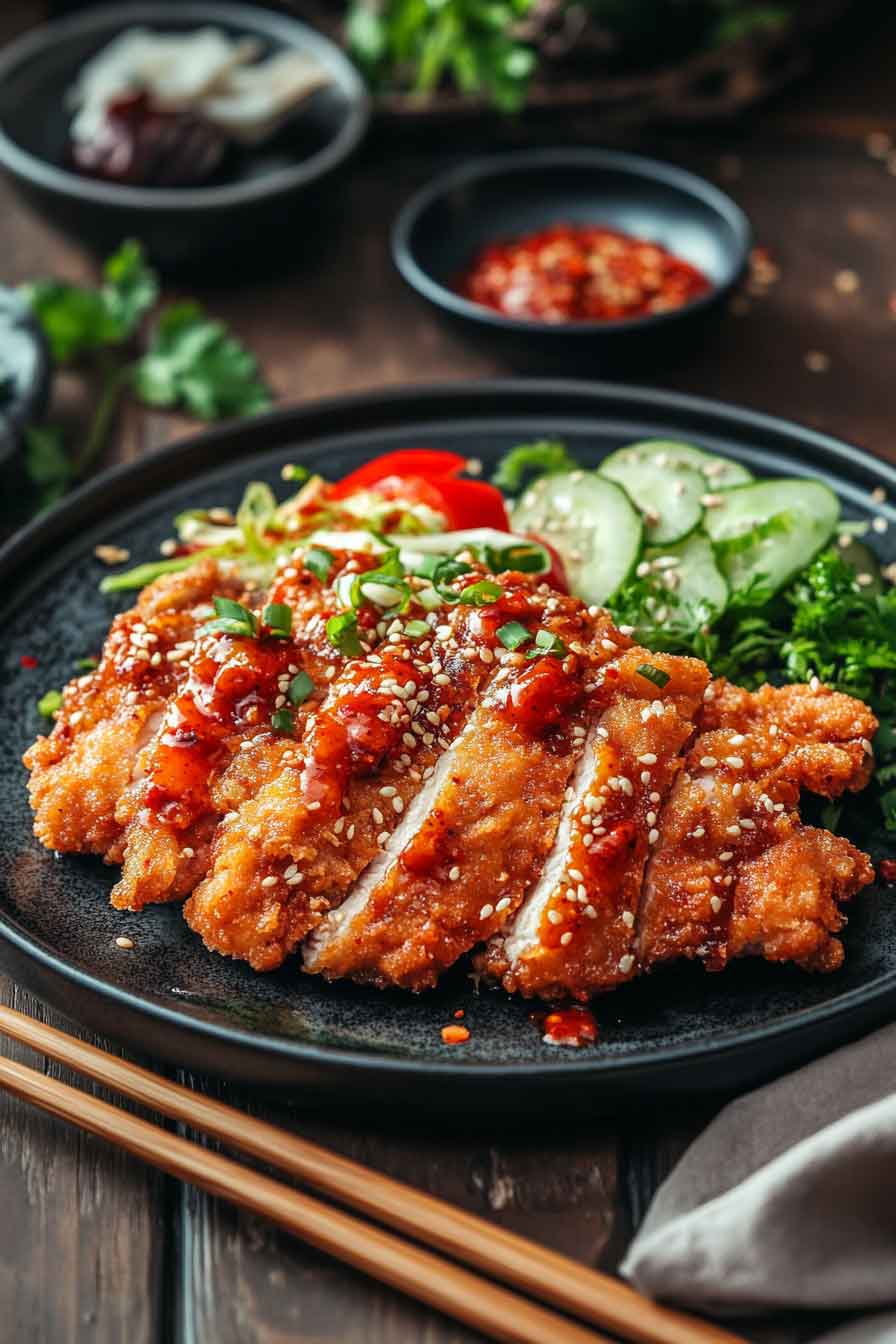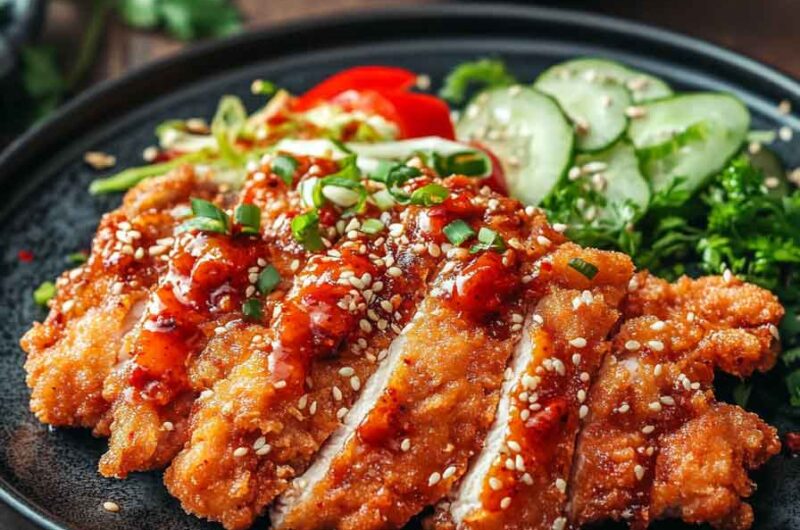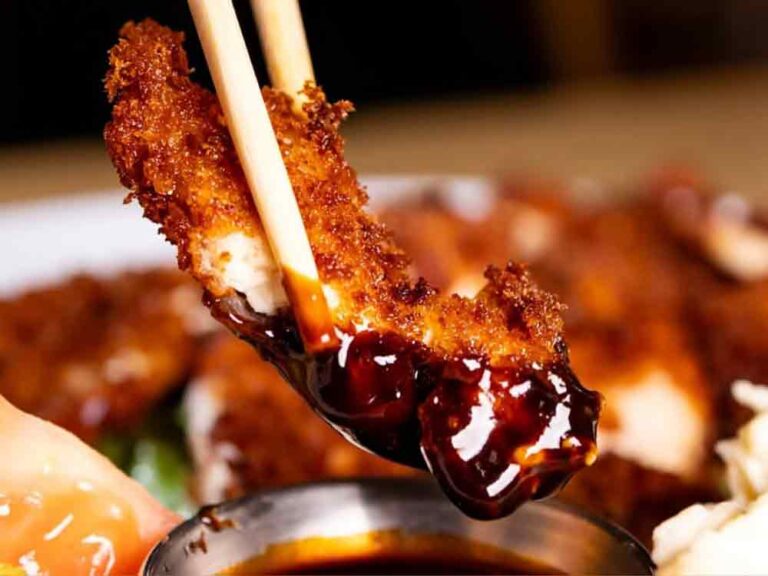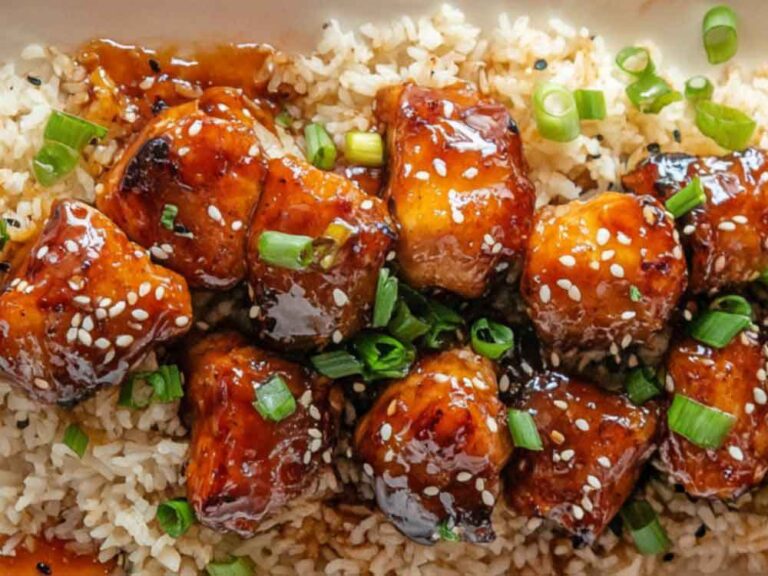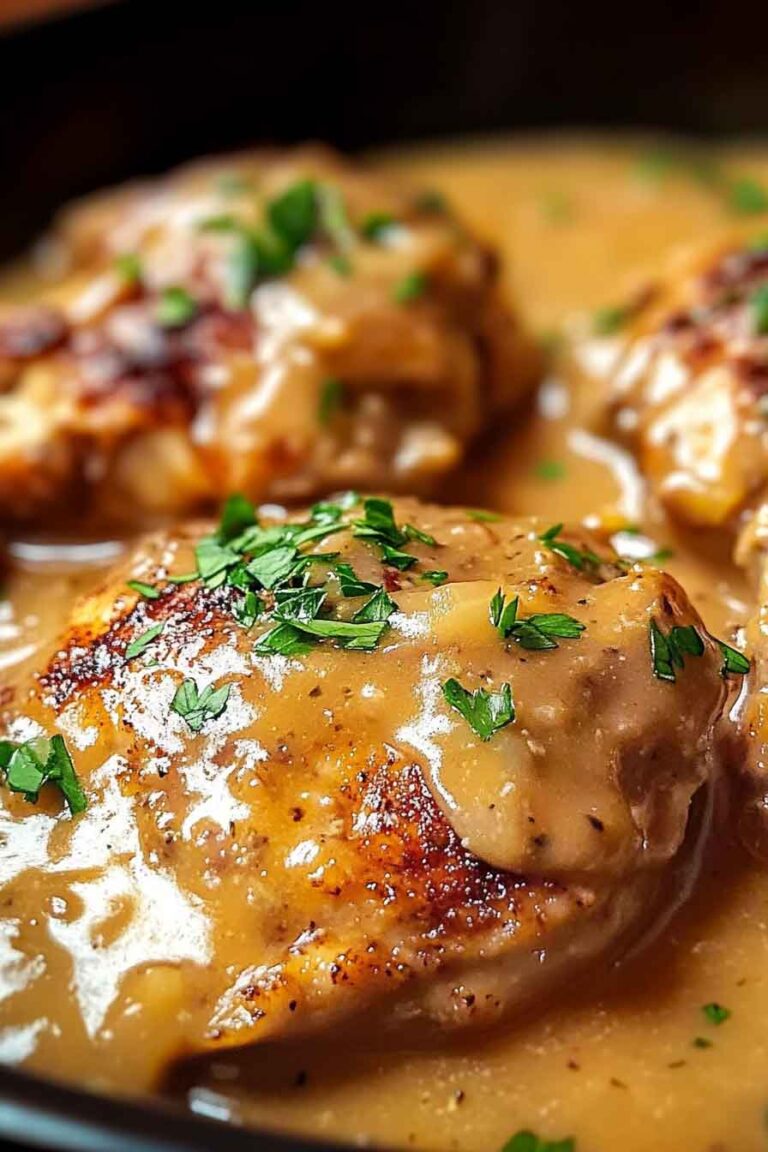Spicy Korean Chicken Katsu
I love finding new meals that wake up my taste buds. Spicy Korean Chicken Katsu does just that. It’s crispy, saucy, and makes my mouth tingle!
When I first tried it, I felt a little nervous about the heat. But oh wow, the sauce was so good—sweet, spicy, and just right! It made every bite so exciting.
Sometimes, I want that extra burst of flavor. This dish really gives me that happy, warm feeling in my tummy. It’s like a little party for my taste buds.
Let’s make it together now! It’s easier than you think, and I’ll show you my simple steps. Come on, let’s start cooking!
Top 5 Kitchen Essentials You Can Buy on Amazon
Why You’ll Love This Recipe
- Crispy Yet Juicy: The crunchy panko coating keeps the chicken tender inside.
- Bold Korean Flavors: Sweet, spicy, and savory sauce adds a kick to every bite.
- Easy to Customize: Adjust the spice level or swap ingredients to suit your taste.
- Great for Meal Prep: The chicken stays crisp when reheated, and the sauce keeps well.
- Family-Friendly: Loved by spice fans, but easy to make milder for kids.
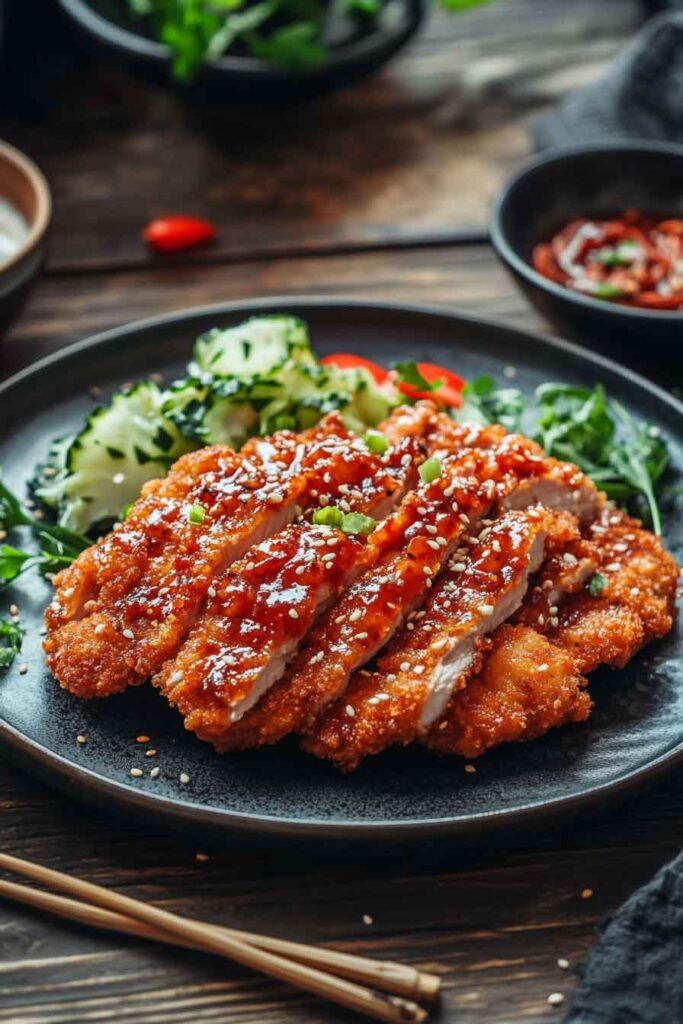
What You Need to Know Before You Start
Prep Time & Cook Time:
- Prep Time: 25 minutes
- Cook Time: 20 minutes
- Total Time: About 45 minutes
Servings:
This recipe serves 4 people. If you need more, simply double the ingredients.
Difficulty:
Easy enough for beginners, but the sauce and frying offer a fun challenge for home cooks.
Required Kitchen Tools
- Cutting board
- Knife
- Mixing bowls (small and medium)
- Whisk
- Large skillet or frying pan
- Tongs
- Paper towels (for draining oil)
- Meat thermometer (optional)

Ingredients for Spicy Korean Chicken Katsu
You’ll need two main parts for this dish: the crispy chicken katsu and the spicy Korean sauce. Each plays a key role, so let’s break it down:
Chicken Katsu Coating
- Chicken Breasts (2 large, boneless, skinless):
These are sliced in half horizontally to make thin cutlets. Thinner pieces cook evenly and stay juicy inside while crisping up outside. - All-Purpose Flour (1 cup):
Flour gives the chicken a dry base so the egg sticks well, ensuring the breadcrumbs stay on during frying. - Garlic Powder (1 teaspoon):
Adds mild garlicky flavor right into the coating for more seasoning. - Salt (1 teaspoon):
Enhances the flavor of the chicken and balances the seasoning in every layer. - Black Pepper (½ teaspoon):
Freshly ground is best for a gentle, warm spice. - Eggs (2 large):
Beaten eggs act as the glue that holds the crispy breadcrumbs onto the chicken. - Golden Breadcrumbs or Japanese Panko (2 cups):
Panko is the best choice for a light, airy crunch. It absorbs less oil compared to regular breadcrumbs, keeping the crust crisp. - Oil (for frying):
Use a neutral oil like vegetable, canola, or sunflower oil. These have high smoke points, making them ideal for frying without overpowering the flavors.
Spicy Korean Sauce (Sweet, Spicy, and Sticky)
- Soy Sauce (3 tablespoons):
Provides a rich, salty base that balances the sweetness and spice in the sauce. - Rice Vinegar (1 tablespoon):
Adds acidity, brightening up the sauce and cutting through the richness of the fried chicken. - Sugar (2 tablespoons):
Balances the heat and adds a subtle sweetness, helping the sauce cling to the katsu. - Honey (1 tablespoon):
Adds thickness and a touch of natural sweetness that blends perfectly with the spicy notes. - Gochujang (2 tablespoons):
The star ingredient – a Korean chili paste that’s spicy, slightly sweet, and deeply savory. It gives the sauce its signature bold flavor and red color. - Garlic (2 cloves, minced):
Fresh garlic gives the sauce a savory, aromatic base. - Ginger (1 teaspoon, grated or minced):
Fresh ginger adds warmth and slight peppery notes, pairing beautifully with garlic and gochujang.
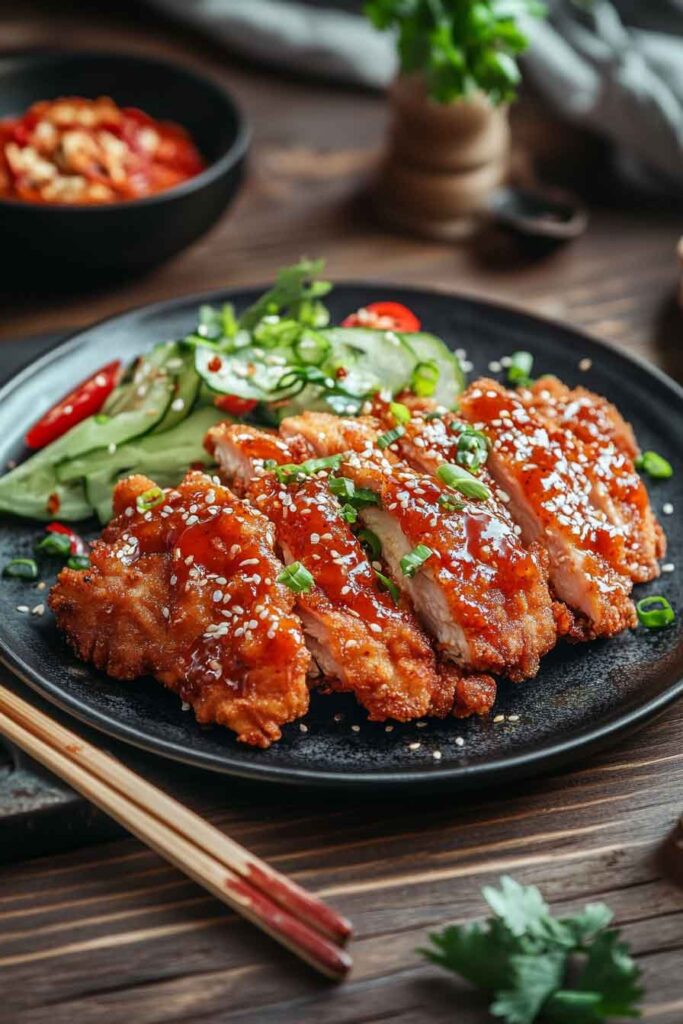
Ingredient Notes and Swaps
- Chicken Thighs: Prefer dark meat? Boneless, skinless chicken thighs work well. They’re juicier but may need an extra 1-2 minutes of cooking time.
- No Gochujang? Substitute with Sriracha, though it won’t have the same fermented depth. Add a teaspoon of tomato paste for color and thickness.
- Gluten-Free?
- Use gluten-free breadcrumbs.
- Swap soy sauce with tamari or a gluten-free alternative.
- Use cornstarch instead of flour for the coating.
- Less Heat? Reduce the gochujang or mix it with ketchup to tone down the spice.
- More Heat? Add red pepper flakes or a dash of hot sauce into the sauce for extra kick.
Variations for Spicy Korean Chicken Katsu
- Add Sesame Oil: Stir in a teaspoon of toasted sesame oil to the sauce for a rich, nutty flavor.
- Crispy Baked Katsu: Bake at 400°F (200°C) for 25-30 minutes, flipping halfway. Spray with oil before baking for a golden crust.
- Air Fryer Option: Cook at 375°F (190°C) for 12-14 minutes, flipping halfway. Lightly spray with oil.
- Sweet & Sticky: Increase honey for a milder, more caramel-like sauce.
- Extra Crunch: Mix panko with sesame seeds or crushed cornflakes for added texture.
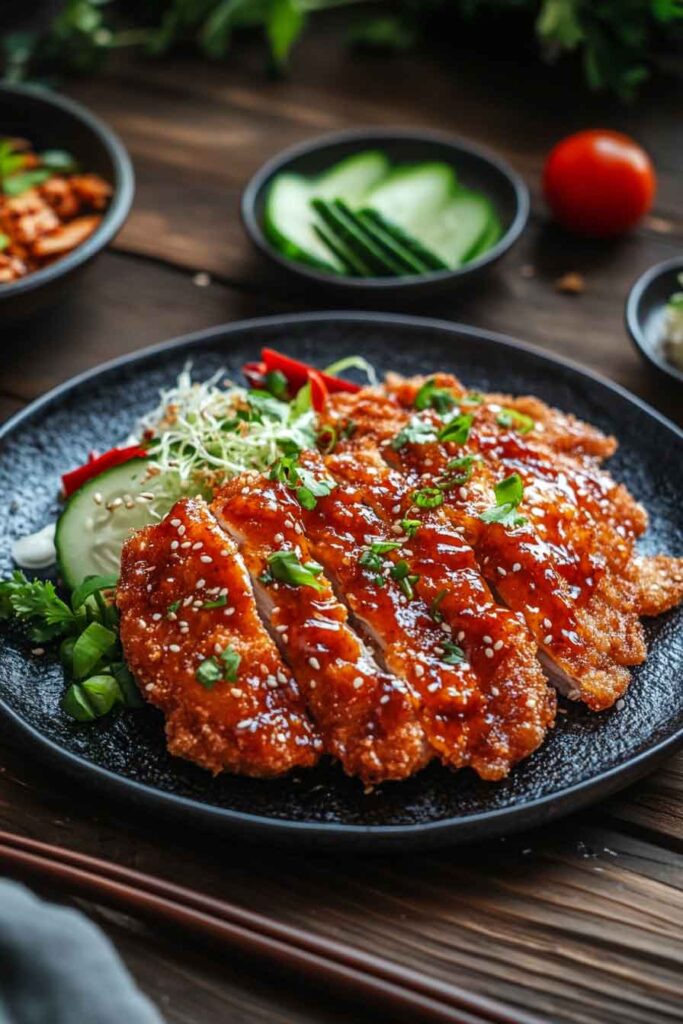
How to Make Spicy Korean Chicken Katsu – Step-by-Step Instructions
1. Prepare the Chicken
a. Slice the Chicken:
- Place each chicken breast on a cutting board.
- Use a sharp knife to slice it horizontally into two thin cutlets.
(Tip: If your chicken is thick, pound it lightly with a rolling pin or meat mallet to ensure even thickness.)
b. Season the Chicken:
- Pat the chicken dry with paper towels.
- Season both sides with salt, black pepper, and garlic powder.
2. Set Up the Breading Station
Prepare three shallow bowls:
- Bowl 1: Flour mixture
Mix flour, garlic powder, salt, and black pepper. - Bowl 2: Eggs
Beat 2 eggs in a bowl until smooth. - Bowl 3: Panko Breadcrumbs
Pour panko breadcrumbs into a bowl.
3. Bread the Chicken
Follow this exact order:
- Dredge the chicken in the flour, shaking off excess.
- Dip into the beaten eggs, letting any extra drip off.
- Coat in panko breadcrumbs, pressing gently so they stick well.
(Tip: Pressing the breadcrumbs onto the chicken helps create a thick, even crust.)
4. Fry the Chicken
a. Heat the Oil:
- Pour about ½ inch of oil into a large skillet.
- Heat over medium heat until it reaches 350°F (175°C).
(Tip: If you don’t have a thermometer, drop a breadcrumb into the oil—it should sizzle immediately but not burn.)
b. Fry in Batches:
- Carefully place 2 pieces of chicken into the hot oil.
- Fry for 3-4 minutes per side, until golden brown and crispy.
- Use tongs to flip the chicken gently.
- Once cooked, transfer to a plate lined with paper towels to drain excess oil.
(Tip: Avoid overcrowding the pan, or the temperature will drop, and the chicken won’t crisp properly.)
5. Make the Spicy Korean Sauce
While the chicken is frying, prepare the sauce:
a. Combine Ingredients:
In a small saucepan, mix together:
- 3 tablespoons soy sauce
- 1 tablespoon rice vinegar
- 2 tablespoons sugar
- 1 tablespoon honey
- 2 tablespoons gochujang
- 2 cloves garlic, minced
- 1 teaspoon ginger, grated
b. Cook the Sauce:
- Heat the mixture over medium heat.
- Stir constantly until the sugar dissolves, and the sauce thickens slightly (about 3-4 minutes).
- Remove from heat and let it cool.
(Tip: The sauce should be thick enough to coat the back of a spoon but still pourable.)
6. Assemble and Serve
a. Slice the Chicken:
- Once rested for a minute, slice the chicken into strips (about ¾-inch thick).
b. Drizzle with Sauce:
- Arrange the crispy chicken on a plate.
- Spoon the spicy Korean sauce over the top or serve it on the side for dipping.
(Tip: Garnish with sesame seeds or chopped green onions for extra flavor.)

Serving and Decoration Ideas
Spicy Korean Chicken Katsu is versatile. It can be the star of a simple weeknight dinner or a fun weekend meal. Here are some serving ideas:
How to Serve Spicy Korean Chicken Katsu
- With Steamed Rice: Classic pairing. The mild rice balances the spicy sauce.
- Over Shredded Cabbage: Adds freshness and crunch. Drizzle with sesame dressing for extra flavor.
- With Pickled Vegetables: Korean-style pickles (like radish or cucumber) cut through the richness.
- Inside a Sandwich: Serve in a brioche bun with lettuce and mayo for a Korean katsu burger.
- In a Rice Bowl: Layer rice, sliced katsu, a fried egg, and sauce. Top with green onions and sesame seeds.
Optional Garnishes:
- Toasted sesame seeds
- Chopped green onions
- Fresh cilantro
- Lime wedges for a citrus twist
Storing Spicy Korean Chicken Katsu
Leftovers:
- Refrigerator: Store cooked chicken in an airtight container for up to 3 days.
- Freezer: Wrap cooled chicken in plastic wrap, then foil. Freeze for up to 2 months.
Reheating:
- Oven: Bake at 350°F (175°C) for 10-12 minutes.
- Air Fryer: Heat at 350°F (175°C) for 5-7 minutes.
- Avoid Microwave: It will soften the crispy coating.
Sauce Storage:
- Store in a jar in the fridge for up to 1 week.
- Reheat gently on the stove or microwave before serving.
Nutrition Information (Per Serving)
| Nutrient | Amount (Approximate) |
|---|---|
| Calories | 480 kcal |
| Protein | 36 g |
| Carbohydrates | 45 g |
| Fat | 18 g |
| Saturated Fat | 3 g |
| Sodium | 870 mg |
| Sugar | 12 g |
(Note: Nutrition may vary based on portion size and frying oil absorption.)
Spicy Korean Chicken Katsu
Course: Chicken4
servings25
minutes20
minutes480
kcalIngredients
- Chicken Katsu:
2 large boneless, skinless chicken breasts (sliced in half lengthwise)
1 cup all-purpose flour
1 teaspoon garlic powder
1 teaspoon salt
½ teaspoon black pepper
2 large eggs (beaten)
2 cups panko breadcrumbs
Oil (for frying)
- Spicy Korean Sauce:
3 tablespoons soy sauce
1 tablespoon rice vinegar
2 tablespoons sugar
1 tablespoon honey
2 tablespoons gochujang (Korean chili paste)
2 cloves garlic (minced)
1 teaspoon ginger (grated)
Directions
- Prepare the Chicken:
Slice chicken breasts into thin cutlets.
Season both sides with garlic powder, salt, and black pepper. - Set Up Breading Station:
Bowl 1: Flour mixture.
Bowl 2: Beaten eggs.
Bowl 3: Panko breadcrumbs. - Bread the Chicken:
Dredge in flour.
Dip into eggs.
Coat with panko, pressing gently. - Fry the Chicken:
Heat ½ inch oil in a skillet over medium heat (350°F).
Fry chicken in batches, 3-4 minutes per side, until golden and cooked through.
Drain on paper towels. - Make the Sauce:
Combine soy sauce, rice vinegar, sugar, honey, gochujang, garlic, and ginger in a saucepan.
Heat over medium, stirring, until sugar dissolves and sauce thickens (3-4 minutes). - Serve:
Slice chicken into strips.
Drizzle with sauce or serve on the side. - Optional Garnishes:
- Sesame seeds
Green onions
Spicy Korean Chicken Katsu FAQs
1. Can I bake instead of fry?
Yes. Bake at 400°F (200°C) for 25-30 minutes, flipping halfway. Spray lightly with oil for a crisp finish.
2. How spicy is this sauce?
Moderately spicy. Reduce gochujang for less heat or add more honey for sweetness.
3. Can I make this ahead of time?
Yes. Fry the chicken and store in the fridge. Reheat in the oven or air fryer for crispness.
4. What can I serve as a side dish?
Steamed rice, pickled vegetables, or a light Asian salad work well.
Conclusion
Spicy Korean Chicken Katsu is a flavorful twist on classic comfort food. Crisp on the outside, tender inside, and coated with a bold sauce—it’s a dish that brings heat and satisfaction to your table. Perfect for quick dinners, meal prep, or even a katsu sandwich, this recipe fits every craving.
Try it out and bring a bit of Korean heat to your next meal.
